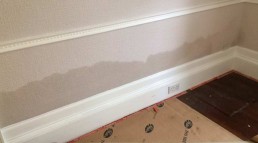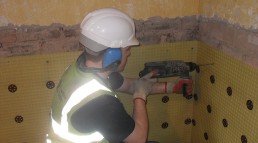What Causes Rising Damp?
Rising damp is caused by a natural process of moisture being absorbed by the permeable wall structure. The water is ‘sucked’ up through the brick, stone or mortar and over time travels up the wall. This water penetration phenomenon is called capillarity. The extent of the rising damp problem depends on factors such as the level of ground next to the property, rainfall, underground water tables and whether there is an effective Damp Proof Course in the wall.
The source of a rising damp problem is often caused by a failure in the Damp Proof Course (DPC). A DPC is a waterproof layer built into the walls of a house and is generally 150 mm above ground level. This membrane ensures water does not travel up through the masonry wall, but if the DPC is not installed correctly or degrades over time, rising damp can occur.
When the DPC is breached, water will begin to travel up through the brick or stone. This is known as capillary action and stops only when the natural force of gravity takes effect and prevents water travelling further. Typically, rising damp only affects ground floor walls up to 1 metre above the ground level.

Capillary Action Explained
Imagine holding a paper towel in a bowl of water and seeing how the water is absorbed, rising up the paper towel slowly over time. This is capillary action at work.
The extent of absorbance from materials used in walls greatly depends on very small tubes, or capillaries, within the brick or stone. Minute capillaries within the building materials can draw water up them without the assistance of a pump or gravity. The diameter of these capillaries determines how high the damp will rise. If the DPC does not cover the whole width of the wall then the DPC will not be fully effective as the damp can still travel up the unprotected part of the wall.
Capillary action is used to great effect in other fields such as medicine, but in masonry it can prove to be damaging and costly. If a misdiagnosis of rising damp is given, the cost for repairs could be even higher as incorrect treatment will not solve the issue. Ensure you thoroughly investigate the source of your damp problem before attempting to correct it. Both condensation and penetrating damp could also be the source of damp issues within your property, so it is important to identify the root cause.
What Happens if Rising Damp is Left Untreated?
The long-term effects of rising damp can be disastrous for a number of reasons and if left untreated will continue deteriorating the wall fabric. If you believe you have a damp problem, consult with a damp specialist as soon as possible to avoid extensive damage.
Moisture rising within the walls of a building can migrate to the inside of your property and can start to peel wallpaper, degrade and disintegrate plaster and cause paint to blister. Simply replacing the wallpaper or paint will not get rid you of the damp problem and it will eventually come back.

A far more serious problem is the structural weakening of the wall. When water rises and causes damp it deposits ground salts into the wall fabric, these salts can attract further moisture from within your property. The strong integrity of the brick, stone and mortar will eventually start to degrade and continue to increase its permeability. The excessive damp can also affect structural timber elements in contact with the affected wall by causing dry or wet rot to take hold of the timber
Older buildings, particularly those with wooden supports and unprotected timbers, are susceptible to wood rotting, commonly known as ‘wet rot’ or ‘dry rot’. The damp promotes the growth of the wood destroying fungus that breaks down the wood fibres and causes it to lose structural integrity.
Solving and Treating Rising Damp
It is important to locate the source of your issue and make sure that the problem is dealt with properly with the correct rising damp treatment. Repairing interior walls or the pointing on the masonry is only a temporary solution and will prove to be an unnecessary expense in the long term.
A bridged or breached DPC will need to be replaced at the source. Perhaps the outside ground is now higher than the damp proof treatment and should be reduced back below the DPC level if possible. Remember to make sure any digging around the house is drained properly as pooling water in holes and trenches will only make the damp problem worse.

If you are unable to remove the bridge from your walls, then the best course of action would be to install a new DPC. For some properties, this could be the first DPC ever installed within the walls.
There are different types of Damp Proof Courses that can be used to suit the specific construction and of age of the building. These different forms such as silicone-based injections, pressure grouting or damp-proof membranes made of polyethylene and electro-osmosis systems are used to suit the site conditions, are the most common forms of DPC repair and replacement. Consulting with a PCA accredited damp proofing specialist to ensure you get the correct rising damp treatment for your property is important.
What to Do Next?
If you believe your property has a rising damp problem, contact a professional preservation specialist. Here at Richardson & Starling, we have been looking after properties since 1935 and our award-winning damp surveyors can help you identify, isolate and repair any damp issues. No matter the age or type of building, we are on hand to provide guidance and advice for any rising damp or any other damp problem. If you require more information, please contact your local branch.